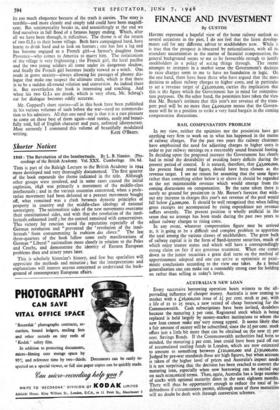FINANCE AND INVESTMENT
By CUSTOS HAVING expressed a hopeful view of the home railway outlook on several occasions in the past, I do not feel that the latest develop- ments call for any different advice to stockholders now. While it is true that the prospect is obscured by nationalisation, with all its attendant uncertainties in the matter of financial compensation, the general background seems to me to be favourable enough to justify stockholders in a policy of seeing things through. The recent attempts to interpret in a market sense the Government's decision to raise charges seem to me to have no foundation in logic. On the one hand, there have been those who have argued that the mere decision to adjust railway charges to higher costs, and in particular to set a revenue target of £43,000,000, carries the implication that this is the figure which the Government has in mind for compensa- tion purposes. On the other hand, the pessimists have taken the view that Mr. Barnes's estimate that this year's net revenue of the trans- port pool will be no more than L4,000,000 means that the Govern- ment will be in a position to strike a very hard bargain in the coming compensation discussions.
RAIL COMPENSATION PROBLEM In my view, neither the optimists nor the pessimists have got anything very firm to work on in what has happened in the matter of railway charges. For the past two years the railway chairmen have emphasised the need for adjusting charges to higher costs in order to put railway earnings on a reasonably sound financial footing. In deciding upon the proposed increase the Government has clearly had in mind the desirability of avoiding heavy deficits during the present period of control. It is natural, therefore, that L43,000,000, the present fixed rental figure, should have been chosen as the revenue target. I see no reason for assuming that the same figure rather than something either below it or above it should be regarded as the net maintainable revenue which would emerge from the coming discussions on compensation. By the same token there is surely no ground for pessimism in Mr. Barnes's forecast that with- out any increase in charges this year's net revenue of the pool would fall below L41,000,000. It should be well recognised that when falling gross receipts are accompanied by rising expenditure net revenue suffers severely. The present position is wholly artificial in the sense that no attempt has been made during the past two years to adjust railway charges to rising costs.
In any event, whatever compensation figure may be arrived at, it is going to be a difficult and complex problem to apportion the total among the various classes of stockholders. The great bulk of railway capital is in the form of fixed-interest securities, much of which enjoy trustee status and which will have a correspondingly strong claim on fair if not generous treatment. When one comes down to the junior securities a great deal turns on the method of apportionment adopted and one can arrive at optimistic or pessi- mistic conclusions according to the view one takes. As a broad generalisation one, can make out a reasonably strong case for holding on rather than selling at today's levels.
AUSTRALIA'S NEW LOAN
Every successive borrowing operation bears witness to the all- pervading influence of cheaper money. Australia is now coming to
market with a ,06,000,coo issue of 21, per cent. stock at par, with a life of 21 to 25 years, a new record of cheap borrowing for the Commonwealth. Cash subscriptions have been invited, doubtless
because the maturing 3 per cent. Registered stock which is being replaced is held largely by money-market institutions to whom the new loan cannot make any very strong appeal. It seems likely that a fair amount of money will be subscribed, since the ai per cent. stock offers just a little bit more than can be obtained on the new 22 per cent. Savings Bonds. If the Commonwealth authorities had been so minded, the maturing 3 per cent. loan could have been paid off out of accumulated sterling funds in London, which are now estimated to amount to something between D20,000,000 and k13o,000,0o0. Judged by pre-war standards these are high figures, but when account is taken of the higher level of prices and Australia's import needs it is not surprising that the decision has been reached to convert the maturing loan, especially when new borrowing can be carried out on such economical terms. Then, again, Australia has a large number of stocks with optional maturity dates in the next eighteen months. There will thus be opportunity enough to reduce the total of in- debtedness if circumstances permit, although most of these maturities will no doubt be dealt with through conversion schemes.


























 Previous page
Previous page